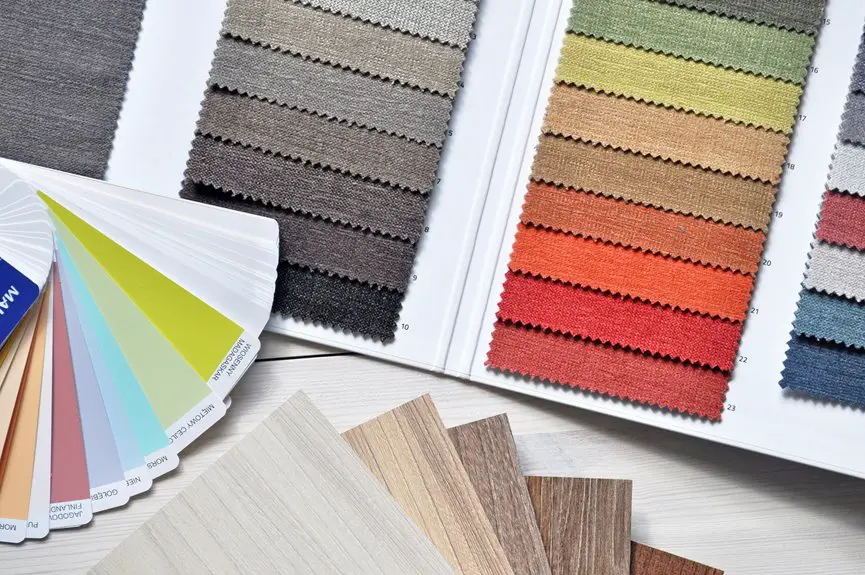You’ll find nonwoven fabrics lack strength and durability, making them prone to tearing and wear. They often don’t hold up well under heat or harsh chemicals and offer limited color and texture options. Plus, their synthetic materials create environmental headaches since they’re tough to recycle and can build up in landfills. If you’re interested in why these drawbacks matter and how they affect uses, there’s more to understand about their limitations and impact.
Table of Contents
Key Takeaways
- Nonwoven fabrics have limited strength and durability, making them prone to tearing and unsuitable for heavy-duty use.
- They resist biodegradation, causing long-term environmental waste and complicating recycling efforts.
- Exposure to high heat and harsh chemicals can degrade or melt nonwoven fabrics, reducing their reliability.
- Nonwovens offer limited aesthetic options, with fewer colors, textures, and patterns compared to woven fabrics.
- Recycling and reusability are challenging due to mixed fibers and binders, often resulting in single-use disposal.
Limited Strength and Durability
One major drawback of nonwoven fabrics is their limited strength and durability. When you rely on these materials, you’ll notice they don’t hold up well under heavy stress or prolonged use.
Nonwovens tend to tear or wear out faster than woven or knitted fabrics because their fibers are bonded rather than interlaced. This makes them less suitable for applications requiring toughness, like heavy-duty bags or long-lasting upholstery.
You might also find that repeated washing or exposure to harsh conditions weakens nonwoven fabrics, causing them to lose shape or integrity quickly.
Environmental Concerns and Waste Management
While nonwoven fabrics might seem convenient, their environmental impact often raises concerns. You should know that these fabrics are usually made from synthetic fibers, which don’t biodegrade easily. This means they can accumulate in landfills, contributing to long-term waste problems.
Nonwoven fabrics, often synthetic, resist biodegradation and can build up in landfills, posing lasting waste challenges.
Plus, recycling nonwoven materials is tricky due to their mixed fiber content and bonding methods. Managing this waste requires more effort and resources.
Here are the key environmental challenges you face with nonwoven fabrics:
- Slow decomposition leads to persistent landfill waste.
- Difficult recycling processes limit reuse options.
- Production often relies on non-renewable petroleum-based materials.
- Improper disposal can pollute ecosystems and waterways.
Understanding these issues helps you make informed choices about using nonwoven fabrics responsibly.
Poor Resistance to Heat and Chemicals
Because nonwoven fabrics often consist of synthetic fibers bonded with adhesives or heat, they tend to break down when exposed to high temperatures or harsh chemicals.
If you use these fabrics in environments with extreme heat, you’ll notice they can melt, shrink, or lose strength quickly.
Similarly, when exposed to strong acids, alkalis, or solvents, nonwovens may degrade, compromising their integrity and functionality.
This limitation means you can’t rely on nonwoven fabrics for applications requiring durability under chemical exposure or heat, such as protective workwear or industrial filters.
You’ll need to carefully consider these factors before choosing nonwovens, especially if your project involves harsh conditions.
Otherwise, you risk product failure and increased replacement costs.
Limited Aesthetic and Texture Options
Nonwoven fabrics don’t offer the same variety of looks and feels that woven or knitted textiles provide. If you’re aiming for unique textures or intricate patterns, nonwovens might let you down. Their manufacturing process limits customization, resulting in more uniform appearances and simpler textures.
Here’s what you should keep in mind:
- Limited texture variety—mostly smooth or felt-like surfaces
- Few color options—usually solid, less vibrant hues
- Minimal pattern possibilities—lack of complex designs
- Lower appeal for fashion or decorative applications
Because of these constraints, you might find nonwovens less suitable when aesthetics and tactile experience matter.
You’ll often need to compromise on style if you choose nonwoven fabrics for your projects.
Challenges in Recycling and Reusability
Even though these fabrics offer practical benefits, you’ll face significant challenges when it comes to recycling and reusability. Nonwoven fabrics often combine different fibers and binders, making it tough to separate materials for efficient recycling.
When you try to reuse them, their structure tends to degrade quickly, reducing durability and performance. Additionally, many nonwovens are designed as single-use products, which limits opportunities for repurposing.
If you’re aiming for sustainability, you’ll find that recycling facilities may not accept these materials due to contamination or complex composition. This creates environmental concerns, as nonwovens can end up in landfills.
Frequently Asked Questions
Are Nonwoven Fabrics More Expensive Than Woven Fabrics?
You might think nonwoven fabrics cost more, but they’re often cheaper due to faster production and less labor. However, depending on quality and application, sometimes woven fabrics can be more cost-effective for durability and reuse.
Can Nonwoven Fabrics Cause Skin Irritation or Allergies?
You might experience skin irritation or allergies from nonwoven fabrics if you have sensitive skin or allergies to certain chemicals used in production. Always check materials and test a small area before prolonged use to avoid reactions.
How Do Nonwoven Fabrics Perform in Moisture Absorption?
You’ll find nonwoven fabrics generally have low moisture absorption, so they don’t hold water well. This makes them great for disposable items but less ideal if you need fabrics that stay dry or wick moisture away.
Are Nonwoven Fabrics Biodegradable?
Did you know only about 20% of nonwoven fabrics are biodegradable? You’ll find many are synthetic, so they don’t break down easily. If you want eco-friendly options, look for those made from natural fibers instead.
What Industries Primarily Use Nonwoven Fabrics?
You’ll find nonwoven fabrics mainly in healthcare for masks and gowns, in automotive for insulation, in construction for geotextiles, and in hygiene products like diapers. These industries rely on their durability and cost-effectiveness.
- The Role of Nonwoven Fabrics in Filtration Systems - July 11, 2025
- Can You Recycle Nonwoven Polypropylene Bags? - July 11, 2025
- How to Care for Your Nonwoven Polypropylene Tote Bags - July 11, 2025





